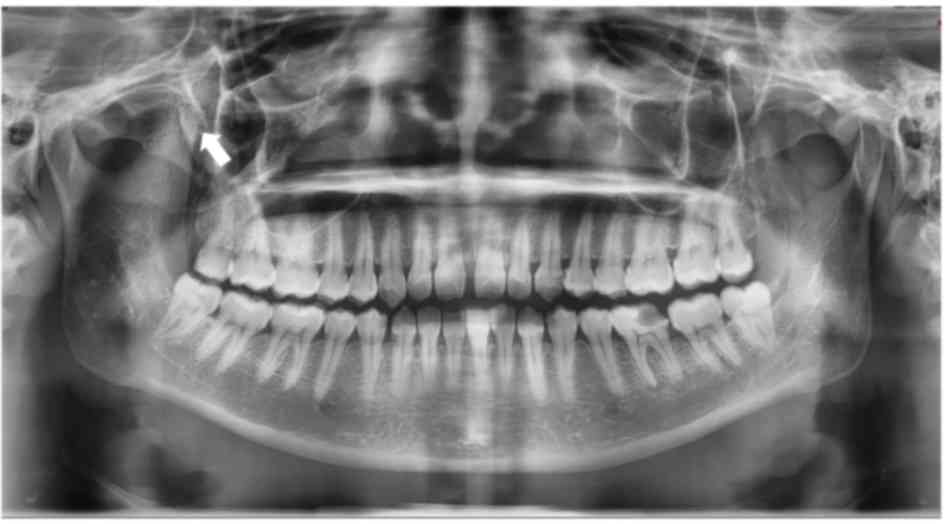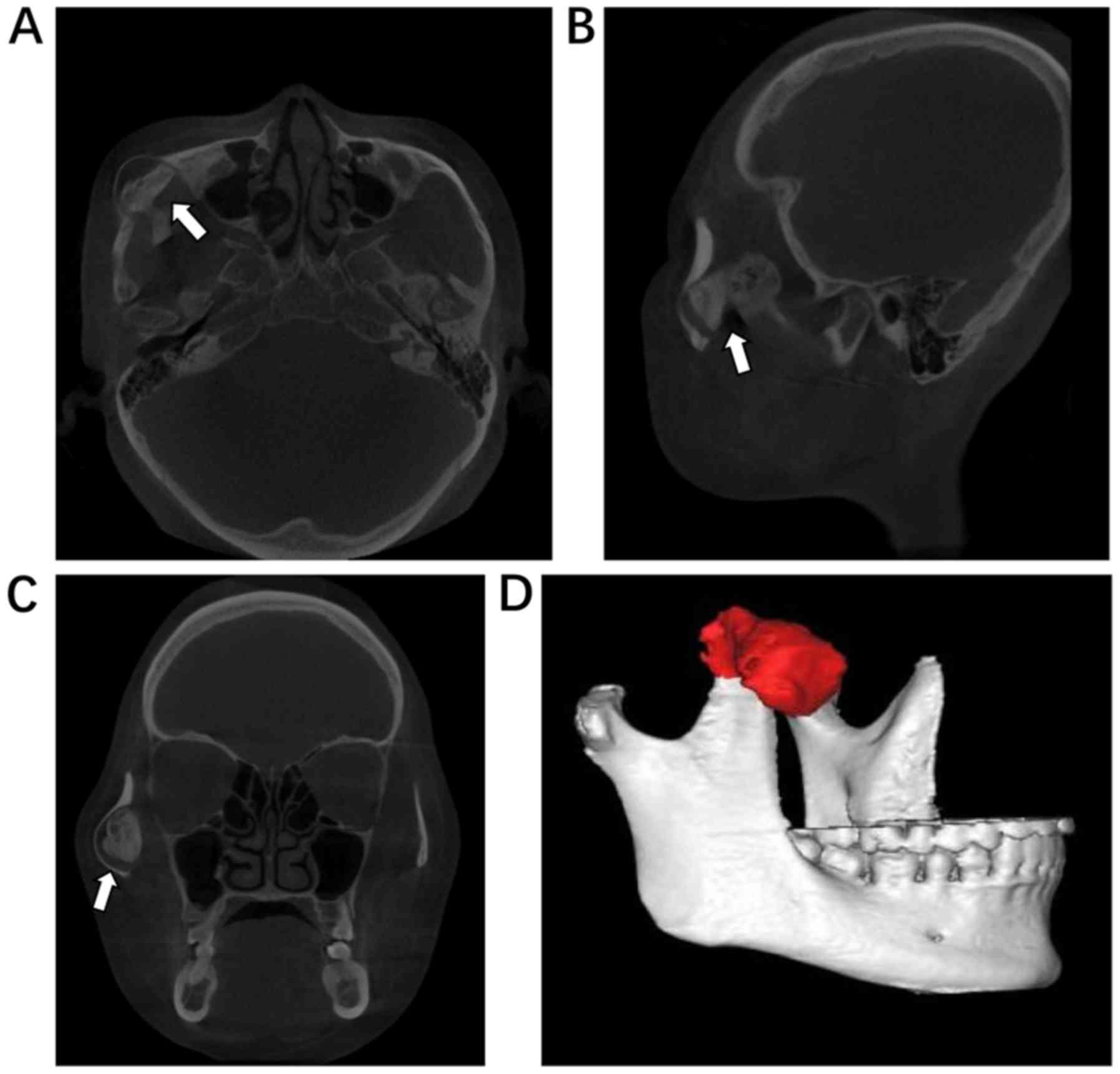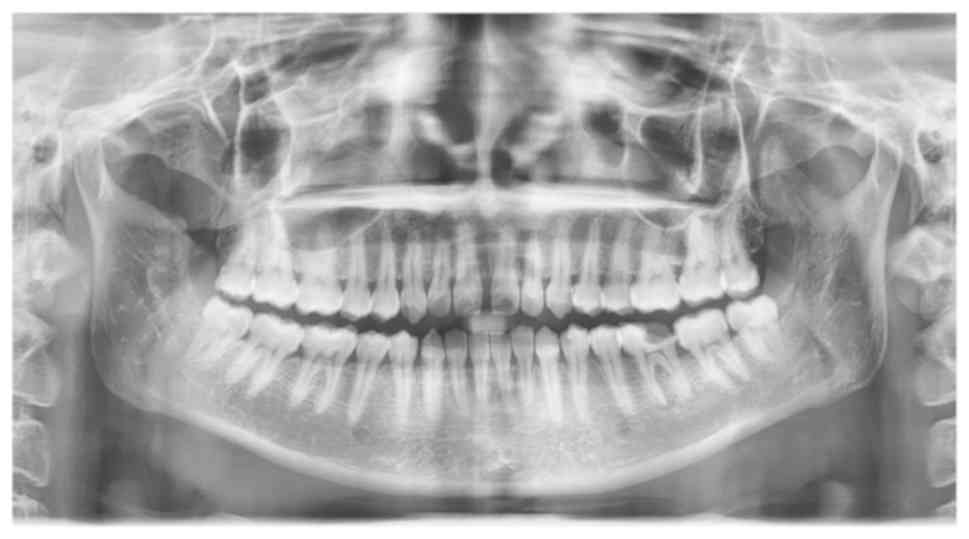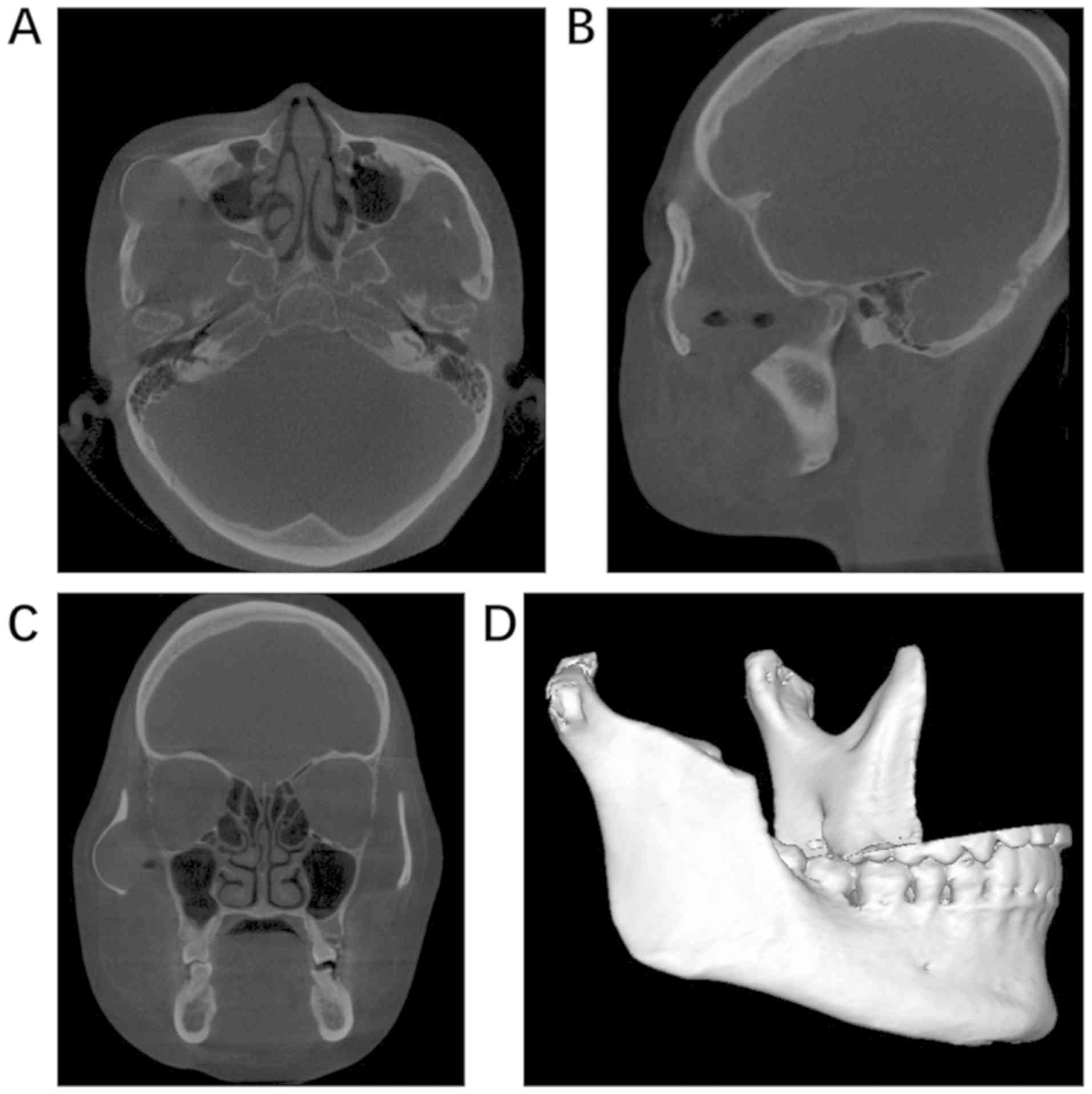|
1
|
Dahlin DC and Unni KK: Bone tumors:
General aspects and data on 8,542 cases. Thomas. 1985.
|
|
2
|
Zhang J, Wang H, Li X, Li W, Wu H, Miao J
and Yuan X: Osteochondromas of the mandibular condyle: Variance in
radiographic appearance on panoramic radiographs. Dentomaxillofac
Radiol. 37:154–160. 2008. View Article : Google Scholar : PubMed/NCBI
|
|
3
|
Mirra JM, Picci P and Gold RH: Bone
tumors. Clinical, radiologic, and patholo-gic correlation.
Investigat Radiol. 26:6371991.
|
|
4
|
Arora P, Deora SS, Kiran S and Bargale SD:
Osteochondroma of condyle: Case discussion and review of treatment
modalities. BMJ Case Rep. 2014(pii): bcr20132007592014. View Article : Google Scholar : PubMed/NCBI
|
|
5
|
Dandriyal R, Giri KY, Pant S, Alam S and
Joshi A: Giant osteochondroma of the coronoid process. J Maxillofac
Oral Surg. 14 (Suppl 1):S412–S416. 2015. View Article : Google Scholar
|
|
6
|
Sreeramaneni SK, Chakravarthi PS, Krishna
Prasad L, Raja Satish P and Beeram RK: Jacob's disease: Report of a
rare case and literature review. Int J Oral Maxillofac Surg.
40:753–757. 2011. View Article : Google Scholar : PubMed/NCBI
|
|
7
|
Brady FA, Sapp JP and Christensen RE:
Extracondylar osteochondromas of the jaws. Oral Surg Oral Med Oral
Pathol. 46:658–668. 1978. View Article : Google Scholar : PubMed/NCBI
|
|
8
|
Traub DJ, Marco WP, Eisenberg E and
Barrows G: Osteochondroma of the maxillary sinus: Report of a case.
J Oral Maxillofac Surg. 48:752–755. 1990. View Article : Google Scholar : PubMed/NCBI
|
|
9
|
Miyawaki T, Kobayashi M, Takeishi M,
Uchida M and Kurihara K: Osteochondroma of the mandibular body.
Plast Reconstr Surg. 105:1426–1428. 2000. View Article : Google Scholar : PubMed/NCBI
|
|
10
|
Tanaka E, Iida S, Tsuji H, Kogo M and
Morita M: Solitary osteochondroma of the mandibular symphysis. Int
J Oral Maxillofac Surg. 33:625–626. 2004. View Article : Google Scholar : PubMed/NCBI
|
|
11
|
Anupam M, Shukla GK, Mishra SC, Bhatia N,
Srivastava AN and Mishra N: Unusual solitary osteochondroma of the
mandibular ramus. J Laryngol Otol. 116:65–66. 2002. View Article : Google Scholar : PubMed/NCBI
|
|
12
|
Vezeau PJ, Fridrich KL and Vincent SD:
Osteochondroma of the mandibular condyle: Literature review and
report of two atypical cases. J Oral Maxillofac Surg. 53:954–963.
1995. View Article : Google Scholar : PubMed/NCBI
|
|
13
|
Lichtenstein L: Bone tumors. Mosby.
1952.
|
|
14
|
Park SH, An JH, Han JJ, Jung S, Park HJ,
Oh HK and Kook MS: Surgical excision of osteochondroma on
mandibular condyle via preauricular approach with zygomatic arch
osteotomy. Maxillofac Plast Reconstr Surg. 39:322017. View Article : Google Scholar : PubMed/NCBI
|
|
15
|
Asanami S, Kasazaki Y and Uchida I: Large
exostosis of the mandibular coronoid process. Report of a case.
Oral Surg Oral Med Oral Pathol. 69:559–562. 1990. View Article : Google Scholar : PubMed/NCBI
|
|
16
|
Totsuka Y, Fukuda H, Iizuka T, Shindoh M
and Amemiya A: Osteochondroma of the coronoid process of the
mandible. Report of a case showing histological evidence of
neoplasia. J Craniomaxillofac Surg. 18:27–32. 1990. View Article : Google Scholar : PubMed/NCBI
|
|
17
|
Kerscher A, Piette E, Tideman H and Wu PC:
Osteochondroma of the coronoid process of the mandible. Report of a
case and review of the literature. Oral Surg Oral Med Oral Pathol.
75:559–564. 1993. View Article : Google Scholar : PubMed/NCBI
|
|
18
|
Çenetoğlu S, Yavuzert R, Oygür T, Akyol G
and Baran NK: Osteochondroma of the coronoid process of the
mandible. Eur J Plast Surg. 19:333–334. 1996. View Article : Google Scholar
|
|
19
|
Kermer C, Rasse M, Undt G and Lang S:
Cartilaginous exostoses of the mandible. Int J Oral Maxillofac
Surg. 25:373–375. 1996. View Article : Google Scholar : PubMed/NCBI
|
|
20
|
Constantinides M, Lagmay V and Miller P:
Coronoid osteochondroma of the mandible: Transzygomatic access and
autogenous bony reconstruction. Otolaryngol Head Neck Surg.
117:S86–S91. 1997. View Article : Google Scholar : PubMed/NCBI
|
|
21
|
Gross M, Gavish A, Calderon S and Gazit E:
The coronoid process as a cause of mandibular hypomobility-case
reports. J Oral Rehabil. 24:776–781. 1997. View Article : Google Scholar : PubMed/NCBI
|
|
22
|
Chen PK, Chang SC, Huang F, Chen YR, Yeow
VK and Williams WG: Transzygomatic coronoidectomy through an
extended coronal incision for treatment of trismus due to an
osteochondroma of the coronoid process of the mandible. Ann Plast
Surg. 41:425–429. 1998. View Article : Google Scholar : PubMed/NCBI
|
|
23
|
Manganaro AM: Osteochondroma of the
coronoid process. Gen Dent. 46:92–94. 1998.PubMed/NCBI
|
|
24
|
Chichareon V, Arpornmaeklong P and
Donsakul N: Fibrodysplasia ossificans progressiva and associated
osteochondroma of the coronoid process in a child. Plast Reconstr
Surg. 103:1238–1243. 1999. View Article : Google Scholar : PubMed/NCBI
|
|
25
|
Hernandez-Alfaro F, Escuder O and Marco V:
Joint formation between an osteochondroma of the coronoid process
and the zygomatic arch (Jacob disease): Report of case and review
of literature. J Oral Maxillofac Surg. 58:227–232. 2000. View Article : Google Scholar : PubMed/NCBI
|
|
26
|
Escuder i de la Torre O, Vert Klok E, Mari
i Roig A, Mommaerts MY and Pericot i Ayats J: Jacob's disease:
Report of two cases and review of the literature. J
Craniomaxillofac Surg. 29:372–376. 2001. View Article : Google Scholar : PubMed/NCBI
|
|
27
|
Emekli U, Aslan A, Onel D, Cizmeci O and
Demiryont M: Osteochondroma of the coronoid process (Jacob's
disease). J Oral Maxillofac Surg. 60:1354–1356. 2002. View Article : Google Scholar : PubMed/NCBI
|
|
28
|
Roychoudhury A, Gupta YK, Parkash H and
Karak AK: Jacob disease: Report of a case and review of the
literature. J Oral Maxillofac Surg. 60:699–703. 2002. View Article : Google Scholar : PubMed/NCBI
|
|
29
|
Capote A, Rodriguez FJ, Blasco A and Munoz
MF: Jacob's disease associated with temporomandibular joint
dysfunction: A case report. Med Oral Patol Oral Cir Bucal.
10:210–214. 2005.(In English, Spanish). PubMed/NCBI
|
|
30
|
Akan H and Mehreliyeva N: The value of
three-dimensional computed tomography in diagnosis and management
of Jacob's disease. Dentomaxillofac Radiol. 35:55–59. 2006.
View Article : Google Scholar : PubMed/NCBI
|
|
31
|
Villanueva J, González A, Cornejo M, Núñez
C and Encina S: Osteochondroma of the coronoid process. Med Oral
Patol Oral Cir Bucal. 11:E289–E291. 2006.PubMed/NCBI
|
|
32
|
Dede U, Tuzuner AM and Kisnisci RS:
Osteochondroma of coronoid process: Jacob's disease. Int J Oral
Maxillofac Surg. 36:11012007. View Article : Google Scholar
|
|
33
|
Etöz OA, Alkan A and Yikilmaz A:
Osteochondroma of the mandibular coronoid process: A rare cause of
limited mouth opening. Br J Oral Maxillofac Surg. 47:409–411. 2009.
View Article : Google Scholar : PubMed/NCBI
|
|
34
|
Thota G, Cillo JE Jr, Krajekian J and
Dattilo DJ: Bilateral pseudojoints of the coronoid process (Jacob
disease): Report of a case and review of the literature. J Oral
Maxillofac Surg. 67:2521–2524. 2009. View Article : Google Scholar : PubMed/NCBI
|
|
35
|
Zhong SC, Xu ZJ, Zhang ZG, Zheng YH, Li TX
and Su K: Bilateral coronoid hyperplasia (Jacob disease on right
and elongation on left): Report of a case and literature review.
Oral Surg Oral Med Oral Pathol Oral Radiol Endod. 107:e64–e67.
2009. View Article : Google Scholar : PubMed/NCBI
|
|
36
|
Yesildag A, Yariktas M, Doner F, Aydin G,
Munduz M and Topal U: Osteochondroma of the coronoid process and
joint formation with zygomatic arch (jacob disease): Report of a
case. Eur J Dent. 4:91–94. 2010.PubMed/NCBI
|
|
37
|
Acosta-Feria M, Villar-Puchades R,
Haro-Luna JJ, Ramos-Medina B and Garcia-Solano E: Limitation of
mouth opening caused by osteochondroma of the coronoid process.
Oral Surg Oral Med Oral Pathol Oral Radiol Endod. 112:e64–e68.
2011. View Article : Google Scholar : PubMed/NCBI
|
|
38
|
Coll-Anglada M, Acero-Sanz J, Vila-Masana
I, Navarro-Cuéllar C, Ochandiano-Caycoia S, López de-Atalaya J and
Navarro-Vila C: Jacob's disease secondary to coronoid process
osteochondroma. A case report. Med Oral Patol Oral Cir Bucal.
16:e708–e710. 2011. View Article : Google Scholar : PubMed/NCBI
|
|
39
|
D'Ambrosio N, Kellman RM and Karimi S:
Osteochondroma of the coronoid process (Jacob's disease): An
unusual cause of restricted jaw motion. Am J Otolaryngol. 32:52–54.
2011. View Article : Google Scholar : PubMed/NCBI
|
|
40
|
Ajila V, Hegde S, Gopakumar R and Babu GS:
Imaging and histopathological features of Jacob's disease: A case
study. Head Neck Pathol. 6:51–53. 2012. View Article : Google Scholar : PubMed/NCBI
|
|
41
|
Ruiz LP and Lara JC: Craniomaxillofacial
features in hereditary multiple exostosis. J Craniofac Surg.
23:e336–e338. 2012. View Article : Google Scholar : PubMed/NCBI
|
|
42
|
Aoki N, Okamura K, Niino D, Iwamoto O and
Kusukawa J: Osteochondroma of the right coronoid process (Jacob
disease): A case report. Cranio. 31:66–69. 2013. View Article : Google Scholar : PubMed/NCBI
|
|
43
|
Stringer DE, Chatelain KB and Tandon R:
Surgical treatment of Jacob's disease: A case report involving an
osteochondroma of the coronoid process. Case Rep Surg.
2013:2537402013.PubMed/NCBI
|
|
44
|
Fan H, Lv X, Shi J, Hu J and Luo E:
One-stage treatment to osteochondroma of the coronoid process and
secondary facial asymmetry with coronoidectomy and reduction
malarplasty: A case report and literature review. J Oral Maxillofac
Surg. 72:1870.e1–1870.e13. 2014. View Article : Google Scholar
|
|
45
|
Losa-Muñoz PM, Burgueño-García M,
González-Martín-Moro J and Sánchez-Burgos R: Osteochondroma of
coronoid process: A rare etiology of Jacob disease.
Craniomaxillofac Trauma Reconstr. 7:306–309. 2014. View Article : Google Scholar : PubMed/NCBI
|
|
46
|
Sawada K, Schulze D, Matsumoto K, Hirai S,
Hashimoto K and Honda K: Osteochondroma of the coronoid process of
the mandible. J Oral Sci. 57:389–392. 2015. View Article : Google Scholar : PubMed/NCBI
|
|
47
|
Mohanty S, Gupta H, Dabas J and Kumar P:
Osteochondroma of maxillofacial region: Tumor arising from two
different developmental bones. J Oral Maxillofac Pathol.
20:3292016. View Article : Google Scholar : PubMed/NCBI
|
|
48
|
Mohan Choontharu M, Buch SA, Babu GS,
Castelino RL, Rao S and Rao K: A rare clinical presentation of an
osteochondroma of coronoid process of mandible. J Dent (Shiraz).
19:325–330. 2018.PubMed/NCBI
|
|
49
|
Jacob O: Une cause rare de constriction
permanente des machoires. Bull Et Mem De La Societe Anatomique De
Paris. 1:917–919. 1899.
|
|
50
|
Langenskiöld A: The development of
multiple cartilagenous exostosis. Acta Orthod Scandinav.
38:259–266. 1967. View Article : Google Scholar
|
|
51
|
Geshickter CF: Tumors of Bone (edition 3).
Philadelphia; PA, Saunders: 1963
|
|
52
|
Navaneetham A, Rao KA, Kumaran S and
Baweja HH: A unique case of multiple osteochondroma: Mandibular
symphysis and femur. Ann Maxillofac Surg. 2:182–184. 2012.
View Article : Google Scholar : PubMed/NCBI
|
|
53
|
Bovee JV, Sakkers RJ, Geirnaerdt MJ,
Taminiau AH and Hogendoorn PC: Intermediate grade osteosarcoma and
chondrosarcoma arising in an osteochondroma. A case report of a
patient with hereditary multiple exostoses. J Clin Pathol.
55:226–229. 2002. View Article : Google Scholar : PubMed/NCBI
|
|
54
|
Staals EL, Bacchini P, Mercuri M and
Bertoni F: Dedifferentiated chondrosarcomas arising in preexisting
osteochondromas. J Bone Joint Surg Am. 89:987–993. 2007. View Article : Google Scholar : PubMed/NCBI
|
|
55
|
Yoda T, Sato T, Abe T, Sakamoto I, Tomaru
Y, Omura K, Hatano N, Takato T and Ishii Y: Long-term results of
surgical therapy for masticatory muscle tendon-aponeurosis
hyperplasia accompanied by limited mouth opening. Int J Oral
Maxillofac Surg. 38:1143–1147. 2009. View Article : Google Scholar : PubMed/NCBI
|
|
56
|
Kung'u A: Tumours of bone and cartilage.
East Afr Med J. 55:572–578. 1978.PubMed/NCBI
|
|
57
|
Kamble V, Rawat J, Kulkarni A, Pajnigara N
and Dhok A: Osteochondroma of bilateral mandibular condyle with
review of literature. J Clin Diagn Res. 10:TD01–TD02.
2016.PubMed/NCBI
|
|
58
|
Wolford LM, Mehra P and Franco P: Use of
conservative condylectomy for treatment of osteochondroma of the
mandibular condyle. J Oral Maxillofac Surg. 60:262–268. 2002.
View Article : Google Scholar : PubMed/NCBI
|
|
59
|
Peroz I, Scholman HJ and Hell B:
Osteochondroma of the mandibular condyle: A case report. Int J Oral
Maxillofac Surg. 31:455–456. 2002. View Article : Google Scholar : PubMed/NCBI
|
|
60
|
Kwon YE, Choi KS, An CH, Choi SY, Lee JS
and An SY: Recurrent osteochondroma of the mandibular condyle: A
case report. Imaging Sci Dent. 47:57–62. 2017. View Article : Google Scholar : PubMed/NCBI
|
|
61
|
Wolford LM, Movahed R, Dhameja A and Allen
WR: Low condylectomy and orthognathic surgery to treat mandibular
condylar osteochondroma: A retrospective review of 37 cases. J Oral
Maxillofac Surg. 72:1704–1728. 2014. View Article : Google Scholar : PubMed/NCBI
|
|
62
|
Ealla KK, Reddy SV, Gadipelly S and Charan
C: Osteochondroma of the palate: An interesting and an unusual case
presentation. J Oral Maxillofac Pathol. 18:303–307. 2014.
View Article : Google Scholar : PubMed/NCBI
|
|
63
|
Xu B, Shi H, Wang S, Wang P and Yu Q:
Secondary chondrosarcoma in the mandibular condyle. Dentomaxillofac
Radiol. 40:320–323. 2011. View Article : Google Scholar : PubMed/NCBI
|



















